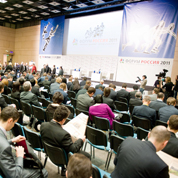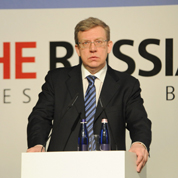Global experts ‘brainstorm’ over economic growth drivers at Russia Forum-2011

The negative impacts of the current economic crisis have been global, not local, and, consequently, measures, including the newly proposed sweeping market regulation reforms and joint intergovernmental actions being put in place across the world to eradicate their aftereffects and prevent future occurrences of such financial cataclysms, also need to be global, both in scope and execution.
This is was one of the landmark conclusions reached by top international and local financial experts gathered in February in Moscow to discuss the impacts of the current global economic malaise and the ways of moving the global and national economies forward in the looming post-crisis era at the Russia Forum-2011.
The high profile investors forum, Russia Forum-2011, hosted annually by Troika Dialog, one of Russia’s top investment banking firms, provides heads of governments’ agencies, CEOs of local and foreign companies, prominent economists and world-renowned scholars an international platform to air their visions on possible sources of new drivers of global economic growth, one of the key items on the this year’s conference agenda.
According to the experts, most of the preventive measures being put in place today are, first and foremost, aimed at eradicating or drastically reducing the existing and future risks capable of putting the global economy again on the brink of bankruptcy. Today, most prominent among these risks are the United States’ exorbitant budget deficit and unprecedented national debt, instability in the eurozone, especially in the so-called ‘PIIGS’ states, the ongoing political volatility in the Middle East, as well as the expected slight dip in China’s hitherto robust GDP growth, which has hovered around a double-digit level for almost a decade.
Global growth to be generated by emerging markets
Speaking on these and other issues at the forum, Joseph Stiglitz, the Columbia University Economics professor and 2001 Nobel economics laureate, noted that although the world might have pulled back from the brink of imminent collapse, it is not completely out of the woods yet. “Precrisis, the deficiency in aggregate demand was filled by a bubble, a problem that has yet to be fully resolved today. Besides, the United States has lost its manufacturing base and replaced it with real estate. The fundamental problems of high leverage and excess amounts of real estate have also yet to be solved.”
“Most of the sweeping measures being put in place today are, first and foremost, aimed at eradicating the existing and future risks capable of putting the global economy once again on the brink of bankruptcy.”
The Nobel laureate also drew the audience’s attention to the fact that most countries are currently withdrawing their financial stimulus programs from national economies, a move that will certainly slow growth in both national and global economies. “Besides, most countries, such as the United Kingdom, are adopting unprecedentedly stringent austerity measures, which will also lead to an economic slowdown. On the other hand, the expansive growth in Asia is driving high commodity prices, which is making the position worse for the United States and Europe.”
With so many negative factors simultaneously in play today, both financial experts and ordinary laymen are currently involved in ‘daily brainstorming exercises’ in search for possible sources of financial drivers for private business and global economic growth in the near future. Thus, according to most expert speakers at the forum, the rising middle class on emerging markets will be one of the most potent global economic growth drivers in the post-crisis era. Similarly, these experts almost unanimously agreed that developed nations, often collectively referred to as the West, will be the last place to seek economic growth generation in the coming years.
Expanding his view on this issue, Sunil Godhwani, the chairman & CEO of Religare Enterprises Ltd, an India-based integrated financial services group, noted that the current globalized economic era has created huge problems for developed markets, which, consequently, are having more hard times living with such problems than the emerging economies. “For instance, about 70% of global economic growth is expected to come from emerging markets this year, while about 445mln consumers will be elevated to the middle class on emerging markets over the next five years.”
Citing India as an example of a country, where consumption has long become a key economic growth driver, Godhwani noted that the size of Indian middle class consumers will be larger than those of United States and Europe combined over the next decade. “The Indian savings rate is at 35%, but little of this enormous fund finds its way into the stock market, a trend that will change with time. Besides, public and corporate governance is getting better in India. All this means that emerging markets will continue to drive growth now and in the years ahead.”
Current trends positive for Russia
In his speech at the forum, Sberbank President & CEO German Gref told the audience that the drivers of local and global economic growth often change,  depending on the other key fundamentals influencing financial markets at a particular point in time. “Previously, consumption, helped by rising leverage, was the key economic growth driver in the United States, but today, such driver has become a thing of the past.” He also highlighted technological changes and breakthroughs as a key potential future growth driver. “Today, consumption on the emerging markets will drive global growth, but it is the technological changes and breakthroughs that will ensure sustainability of such growth in the future, at least, in the western world.”
depending on the other key fundamentals influencing financial markets at a particular point in time. “Previously, consumption, helped by rising leverage, was the key economic growth driver in the United States, but today, such driver has become a thing of the past.” He also highlighted technological changes and breakthroughs as a key potential future growth driver. “Today, consumption on the emerging markets will drive global growth, but it is the technological changes and breakthroughs that will ensure sustainability of such growth in the future, at least, in the western world.”
Gref also noted that such a scenario offers Russia a tremendous opportunity to increase its global competitiveness and labor productivity through the Kremlin’s ongoing policy of modernizing every facet of society and economy, from infrastructure, education, government, technology to energy efficiency, etc. “Within the frameworks of this modernization policy, the production of spectra of commodities, including agricultural ones, can be boosted in Russia. We can also increase the effectiveness of our government. All this will help make Russia one of the key drivers of economic growth in the future.”
Another boon to Russia’s contribution to global economic growth in the post-crisis era, according to Russian Finance Minister Alexei Kudrin, is the government’s plan to boost the current scope of privatization of state assets and stimulate economic competition in the country. “Other positive growth drivers will be Russia’s eventual admission to the WTO, expected later this year, and, of course, a more effective use of the country’s hydrocarbon assets and other natural resources. All these factors can drive growth to a new level in the country.”
Also, the Kremlin’s plans to create a modern post-crisis international financial center in Moscow, devoid of all the fallacies currently associated with the existing global financial hubs that have been accused of causing the ongoing global economic malaise, is also expected to be a new source of growth, not only locally in the domestic economy, but also throughout the post-Soviet region, where Moscow has continued to remain a key political and economic player.
Putting all these issues into practical perspective, Snezana Stoiljkovic, the director for Eastern Europe and Central Asia at International Financial Corp., an affiliate of the World Bank Group, noted that Russia remains the key to economic growth and development in the post-Soviet region. “Russia plans to improve infrastructure and other social facilities across the country and this will require huge financing and partnership from across the world,” she added. “In this regard, the government will also have to improve the development of its financial services sector, especially in the light of the plans to set up a world-standard modern financial center in Moscow. This will be vital to economic growth.”
Generating growth for growth sake is not the best option
However, some experts have cautioned against chasing growth at all costs and by all means as bigger growth per se is not a panacea to all the current negative issues facing national and global economies. “Economic growth is not always good, because social, political and economic stability of a society is more important to the state,” Kotaro Tamura, the president of the eponymous Tamura Institute, otherwise known as the Strategic Initiative Corporation for Economy and Management of Japan, said.
“About 70% of global economic growth is expected to come from emerging markets this year, while about 445mln consumers will be elevated to the middle class on emerging markets over the next five years.”
Calling for radical changes in the existing status-quo in national and global economies as one of the few options left to generate growth in the near future, Kotaro cited Japan, his home country, as one of the first governments, where such changes have become more than imperative today because the post-crisis world is entering a new, knowledge-intensive era. “Japan is running out of money, and its national debt is so high that the government must change. For instance, Japan’s balance sheet is five times higher than that of the United States. Therefore, the country needs to change and reform its institutions in order to generate sustainable economic growth.”
However, Russell Napier, a strategist with CLSA, who has written extensively on issues impacting global equity markets, was not as upbeat as other experts about the prospect of new global economic growth drivers being generated by emerging markets, as such growth, in his words, represents the ‘wrong kind’ of economic expansion. “This is because emerging markets do not have independent and well-established monetary policies. Besides, they usually misallocate capital, which is the last leg of the global money printing bubble.”
Seen in the above context, Napier, indeed, seems to be more of ‘a traditionalist’ in his thinking, as he continues to seek growth potential on the existing developed markets, such as the United States, rather in countries with rapidly expanding economies. “Emerging markets will buy U.S. companies. There will be a new consumer boom in the United States, and this is where we should look for growth in the near future.”












 Web design,
Web design,